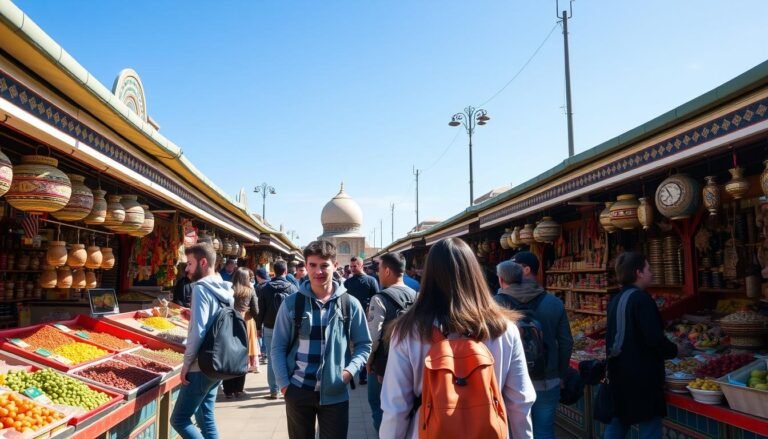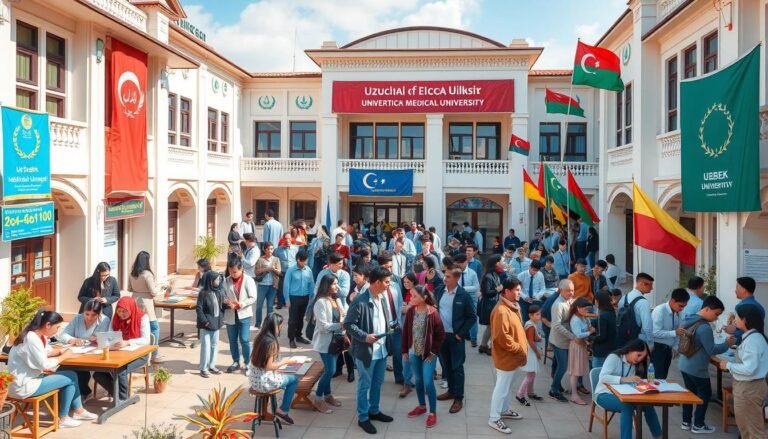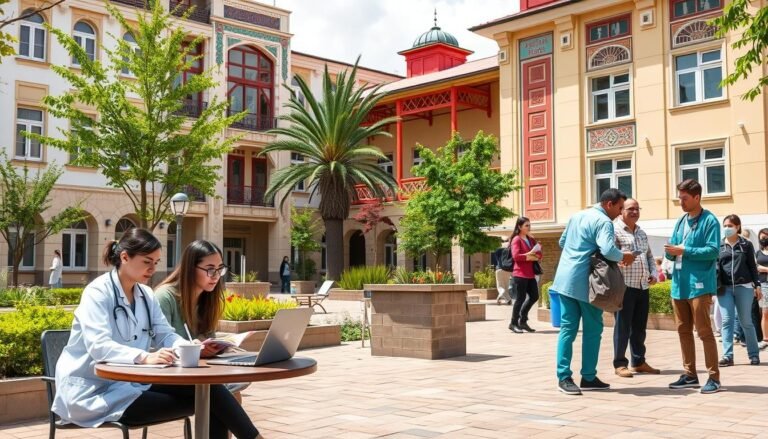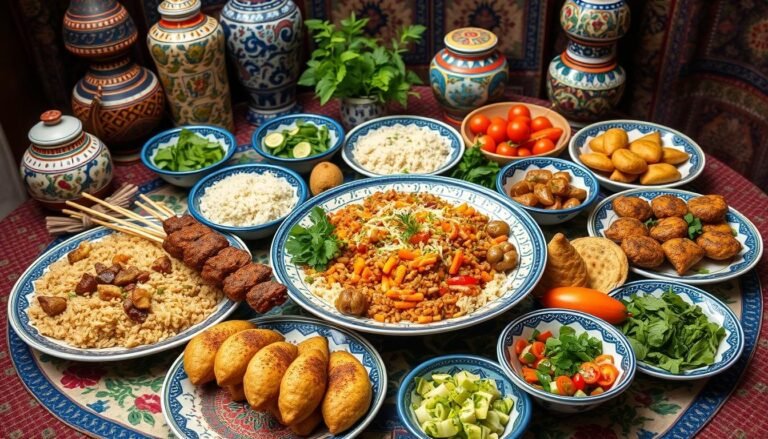Understanding Uzbekistan Culture Guide for Indian Students
Uzbekistan’s rich cultural tapestry can enhance Indian students experiences. The country’s unique culture stems from its Silk Road location. This guide explores Uzbek culture, traditions, and customs for students.
Uzbekistan’s culture is captivating and dynamic. Indian students can immerse themselves in this vibrant environment. Let’s explore what makes this Central Asian country so special.
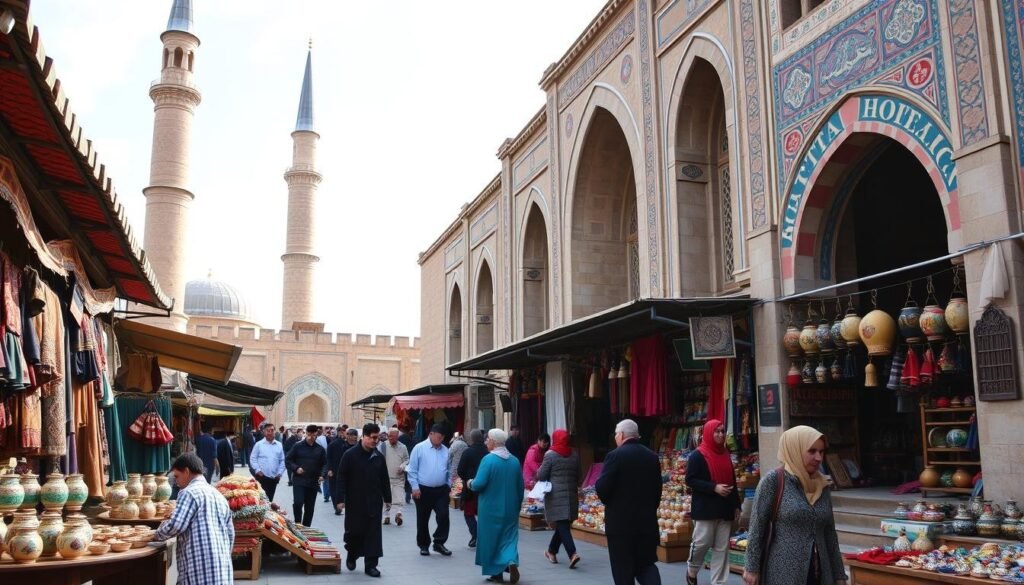
Introduction to Uzbek Culture
Uzbekistan’s cultural heritage blends Persian, Turkic, and Soviet influences. This diverse legacy has shaped Uzbek identity’s core values and traditions.
The country’s rich history reflects in its customs and practices. These elements form a unique tapestry of Uzbek culture.
Overview of Historical Influences
Uzbekistan, located on the Silk Road, has been a crossroads of civilizations. The Silk Road facilitated exchange of goods, ideas, and customs.
This cultural melting pot created a unique blend of Eastern and Western traditions. It has significantly influenced Uzbekistan’s cultural development over centuries.
Key Cultural Values
- Respect for Elders: Uzbek society highly values respecting and honoring the elderly. They are viewed as sources of wisdom and experience.
- Hospitality: Hospitality is central to Uzbek culture. Hosts often go to great lengths to ensure their guests’ comfort and satisfaction.
- Strong Family Ties: Family is the foundation of Uzbek society. Extended families play a vital role in everyday life and decision-making.
Significance of Traditions
Traditions are crucial in Uzbek culture, with many customs preserved from ancient times. These traditions reflect in the country’s architecture, arts, and daily life.
They serve as a living link to Uzbekistan’s rich heritage. After independence, Uzbekistan saw a revival in handicrafts and traditional arts.
This revival showcases the enduring strength of Uzbek cultural identity. It highlights the importance of preserving these time-honored traditions.
| Tradition | Significance |
|---|---|
| Suzani Embroidery | Uzbekistan is famed for its suzani, decorative silk embroideries with bright colors and intricate patterns, which are a symbol of Uzbek artistry and craftsmanship. |
| Puppet Theatre | Puppet theatre has a rich tradition in Uzbekistan, dating back to the Achaemenid Empire in the 5th century BCE, and remains an important part of the country’s cultural heritage. |
| Handwoven Carpets | Carpet workshops are common in Uzbekistan, with handwoven carpets being a traditional element of Uzbek households and a testament to the region’s weaving expertise. |
Daily Life in Uzbekistan
Uzbekistan’s daily life blends traditional and modern practices. It reflects the country’s rich cultural heritage. Family structure, routines, and eating habits shape Uzbek life.
Family Structure and Roles
Uzbek families are typically extended, with multiple generations living together. Elders command respect, while younger members play supportive roles. Women handle household duties and caregiving, while men are primary breadwinners.
Typical Routines and Practices
Uzbeks follow a structured daily routine, starting early. Work or school takes up most daylight hours. Evenings are for family time.
Leisure activities include socializing with neighbors or doing traditional crafts. These often happen in the evening.
Eating Habits and Meal Times
Mealtimes are significant in Uzbek culture. Lunch is the main meal of the day. Families gather to enjoy traditional dishes like plov, shurpa, and samsa.
Dining is more than just eating. It’s a cherished social occasion to strengthen family bonds and share stories.
Uzbekistan’s daily life centers on family, tradition, and community. These elements form the foundation of their rich cultural tapestry.
Language and Communication
Understanding Uzbekistan’s local language is vital for Indian students. Uzbek is the official language, written in Latin script since 1992. Russian is also widely used in urban areas and higher education.
Overview of the Uzbek Language
Uzbek is a Turkic language spoken by most ethnic Uzbeks. It evolved from Chagatai and shares similarities with other Central Asian languages. Uzbek uses suffixes for grammatical functions and follows a subject-object-verb word order.
The language has six cases and no grammatical gender or articles. Plurals are formed by adding “-lar” to nouns. Uzbek is an agglutinative language, meaning it combines morphemes to create words.
Common Phrases for Students
- Salom (Hello)
- Rahmat (Thank you)
- Iltimos (Please)
- Kechirasiz (Excuse me)
- Men tushunmadim (I don’t understand)
- Nima deb aytyapsiz? (What are you saying?)
- Bu qanday bo’ladi? (How does this work?)
- Qani, ko’rsating (Can you show me?)
Non-Verbal Communication Styles
Non-verbal communication is crucial in Uzbekistan. Eye contact is usually maintained during conversations. However, it may be avoided with elders or authority figures as a sign of respect.
Gestures and body language are important for conveying meaning and showing respect. Understanding these nuances will help Indian students interact more effectively. This knowledge aids in navigating patient care and community interactions with cultural sensitivity.
Important Customs and Etiquette
Grasping Uzbek cultural customs is key for Indian students visiting the country. It helps build connections and navigate daily interactions. Let’s explore Uzbek culture’s nuances to enhance your experience.
Greetings and Polite Behavior
Uzbek greetings often involve warm handshakes and asking about family and health. When greeting elders, place your right hand over your heart. Maintain eye contact and a friendly demeanor in all interactions.
Gift-Giving Traditions
Gift-giving is important in Uzbek culture, especially when visiting homes. Bring a small gift like sweets, flowers, or wine. Present gifts with your right hand or both hands to show respect.
Dining Etiquette for Guests
Remove your shoes when entering an Uzbek home. Wait for the eldest person to start eating before you begin. Use your right hand for eating and passing food.
Guests are often given the most honored seats at the table. Respect for elders is crucial in Uzbek dining culture.
| Uzbek Custom | Description |
|---|---|
| Tea Ceremony | The tea ceremony holds significant importance in Uzbek hospitality, with the host being responsible for preparing and serving the tea. |
| Beshik-Tuyi Ritual | This celebration, held on the 7th, 9th, and 11th days after a baby’s birth, marks the placement of the newborn in the cradle. |
| Fatiha-tui Ceremony | The Fatiha-tui ceremony marks the betrothal in Uzbek weddings, involving the exchange of gifts and the setting of the wedding date. |
Learning these customs will help you navigate Uzbekistan with confidence. You’ll show respect for local culture and make the most of your Indian student experience.
Religion and Spirituality
Uzbekistan boasts a rich tapestry of religious traditions. Islam dominates, with 94% of Uzbeks following Sunni Islam. Other faiths include Christianity, Judaism, Baha’i, and Buddhism.
Religious influence varies across Uzbekistan. Urban areas tend to be more secular than rural regions. However, Islamic influence permeates Uzbek culture, shaping holidays, family life, and community bonds.
Major Religions in Uzbekistan
- Sunni Islam (94% of the population)
- Russian Orthodox Christianity (2.2% of the population)
- Other religions, including Judaism, Baha’i, and Buddhism (3.8% of the population)
The Role of Islam in Uzbek Daily Life
Islam deeply influences many Uzbeks’ lives. Religious practices are woven into the country’s cultural fabric. This includes observing major Islamic holidays and emphasizing family and community in religious life.
Uzbek Religious Festivals and Observances
- Ramadan – The holy month of fasting and spiritual reflection
- Eid al-Fitr – The celebration marking the end of Ramadan
- Eid al-Adha – The festival of sacrifice, commemorating the willingness of the prophet Ibrahim (Abraham) to sacrifice his son
- Mawlid – The birthday celebration of the Prophet Muhammad
Uzbekistan also has a rich Sufi tradition. These practices have shaped the country’s spiritual landscape for centuries. The UNESCO Chair at the International Islamic Academy of Uzbekistan studies these diverse religious traditions.
Arts and Crafts
Uzbekistan’s cultural heritage shines through its traditional arts and crafts. Skilled artisans create mesmerizing works, from Rishtan’s intricate ceramics to Margilan’s vibrant textiles. These crafts have been passed down through generations.
Traditional Handicrafts
Uzbek handicrafts showcase the country’s rich history. The Center documented craft practices of fifty women-run artisan enterprises across Central Asia. This effort highlights the incredible diversity of Uzbek artistry.
Basma embroidery, an endangered craft, is being preserved in the Qashqadaryo Region. The Hunarmand Association, with nearly 100,000 registered artisans, promotes and sustains these timeless techniques.
Music and Dance
Music and dance play a vital role in Uzbek culture. Traditional instruments like the dutar and karnay remain popular today. These art forms blend elements from various ethnic groups and eras.
Contemporary artists enrich Uzbekistan’s vibrant arts scene. They combine traditional motifs with modern techniques. Human House in Tashkent showcases work from over 260 designers and artisans across Central Asia.
Notable Contemporary Artists
Uzbekistan’s contemporary art scene reflects its enduring artistic legacy. Designers and artisans at Human House push the boundaries of traditional Uzbek art. Their works blend history with modern influences.
Sayfi, an artist, noticed changes in Uzbekistani artisans’ work after traveling abroad. He plans to expand Human House with a museum, library, and artist residencies.
Uzbekistan’s arts and crafts showcase its rich cultural heritage. From Rishtan ceramics to Margilan textiles, the country’s artistic scene captivates. As artisans innovate, Uzbek art continues to inspire the world.
Cuisine of Uzbekistan
Uzbekistan’s cuisine blends Central Asian flavors, showcasing the country’s rich cultural heritage. Uzbek food offers a tantalizing experience with its hearty national dish, plov, and diverse regional specialties.
Must-Try Uzbek Dishes and Ingredients
Uzbek cuisine features savory meat dishes, with beef and lamb as the main proteins. Horse meat is a delicacy, while poultry is less common. Fish dishes are rare due to the country’s landlocked location.
Shashlik, or grilled meat skewers, are popular Uzbek favorites. Samsa, meat-filled pastries, are another must-try dish for visitors.
Regional Variations in Uzbek Food
Uzbekistan’s regions offer unique culinary specialties, highlighting the country’s gastronomic diversity. Shurpa, a lamb and vegetable soup, has boiled and fried variations across the country.
Laghman, featuring handmade noodles, meat, and vegetables, is a beloved regional dish. Some areas serve nohat shurak, a chickpea soup with horse sausage.
Dining Out vs. Home Cooking in Uzbekistan
Home cooking remains common in Uzbekistan, but dining out is gaining popularity in urban areas. Families often prepare plov, a rice dish with meat and vegetables, for special occasions.
Restaurants and teahouses (chaikhanas) are becoming more popular. These eateries allow visitors to explore Uzbek cuisine’s diverse flavors beyond home-cooked meals.
| Uzbek Cuisine Highlights | Key Facts |
|---|---|
| Meat Dishes |
|
| Uzbek Soups |
|
| Uzbek Dairy Products |
|
| Uzbek Bread |
|
Education System in Uzbekistan
Uzbekistan’s education system plays a crucial role in national development. The country has modernized its educational infrastructure and aligned curricula with global standards. This system aims to create a skilled workforce for the nation’s progress.
Structure of National Education
The Uzbek education system has several key components:
- Primary education (grades 1-4)
- Secondary education (grades 5-11)
- Vocational and specialized secondary education
- Higher education (universities and specialized institutes)
The Ministry of Public Education partners with USAID to improve learning outcomes. They’re introducing new educational standards and curricular reforms across all grade levels.
Higher Education Opportunities
Uzbekistan’s higher education system offers diverse options. These include universities, specialized institutes, and academies. Medical education is highly respected, producing skilled healthcare professionals.
The country is upgrading its higher education system. New initiatives focus on enhancing research, international collaboration, and digital learning platforms.
Cultural Differences in Learning Styles
Uzbekistan’s education system shares some similarities with Western models. However, there are cultural differences in learning styles and classroom dynamics. Uzbek students may be used to a more hierarchical teacher-student relationship.
There’s a greater emphasis on memorization and recitation alongside critical thinking. Understanding these cultural nuances can help international students adapt more effectively.
| Statistic | Value |
|---|---|
| New standards of educational achievement by grade and subject being launched in Uzbekistan | Yes |
| Education professionals who participated in the Product Review Orientation Workshop | More than 60 |
| Duration of the Workshop | January 14 to February 1 |
| Uzbekistan Education for Excellence Program launched by USAID | December 2019 |
| Goal of the “Uzbekistan 2030” Strategy for book lovers and book publications | 5 million young book lovers, 100 works of art, 50 books for children and adolescents annually, and digitize a book fund of almost 40 million books |
Festivals and Celebrations
Uzbekistan’s cultural scene is alive with diverse festivals and holidays. These events showcase the nation’s history, traditions, and spirit. They offer a unique peek into Uzbek culture.
Overview of Major Holidays
Uzbekistan officially celebrates 10 national holidays as non-working days. These include key events that hold special meaning for the country.
- Independence Day (September 1) – Marking the country’s independence from Soviet occupation in 1991.
- Navruz (March 21) – The spring equinox celebration, featuring traditional dishes and festivities.
- Eid al-Fitr and Eid al-Adha – The two main Islamic holidays, observed by the Muslim majority population.
- Day of Defenders of the Motherland (January 14) – Honoring the Uzbek armed forces.
- Women’s Day (March 8) – Celebrated as “Mothers Day” and the arrival of spring.
Cultural Significance of Festivals
Uzbek festivals are deeply rooted in the country’s cultural heritage. They often feature traditional music, dance, and elaborate feasts. These events reveal the rich tapestry of Uzbek traditions.
- Boysun Bahori – A spring festival in Surkhandarya Province, showcasing local customs and rituals.
- Shark Taronalari – An international world music festival held annually in Samarkand since 1997.
Student Participation in Events
Uzbekistan encourages students to join in cultural events and festivals. This helps them understand and appreciate the country’s traditions better. Students gain valuable insights into Uzbek customs through these celebrations.
By taking part, students enrich their cultural experiences and knowledge. They learn the deeper meaning behind Uzbek traditions and symbols.
| Holiday | Date | Significance |
|---|---|---|
| Independence Day | September 1 | Marks Uzbekistan’s independence from Soviet occupation in 1991. |
| Navruz | March 21 | Celebrates the spring equinox with traditional dishes and festivities. |
| Eid al-Fitr | Variable | Marks the end of the holy month of Ramadan for the Muslim population. |
| Eid al-Adha | Variable | Commemorates the Islamic festival of sacrifice. |
| Day of Defenders of the Motherland | January 14 | Honors the Uzbek armed forces and their role in protecting the country. |
| Women’s Day | March 8 | Celebrated as “Mothers Day” and the arrival of spring. |
Navigating Healthcare in Uzbekistan
International students in Uzbekistan should understand the country’s healthcare system. It includes public and private facilities, each with unique features. Knowing these differences is crucial for seeking medical care.
Overview of the Healthcare System
Uzbekistan’s healthcare blends modern and traditional practices. Public facilities offer primary care, hospital treatment, and specialized services. Private healthcare has also grown popular recently.
Traditional healing methods coexist with Western-style medicine. These include herbal remedies and holistic approaches. This mix provides diverse options for patients.
Cultural Considerations in Patient Care
Understanding cultural norms is vital when seeking medical attention in Uzbekistan. Respect for elders and gender preferences are important factors. Family often plays a key role in medical decisions.
Addressing these cultural aspects can improve the patient experience. It helps create a more positive and meaningful healthcare journey.
Communication Between Doctors and Patients
Doctor-patient communication in Uzbekistan may differ from Western practices. The relationship is often more formal and hierarchical. Patients usually defer to the doctor’s authority and expertise.
Understanding these communication styles is crucial. It can lead to more effective interactions and better health outcomes.
| Key Aspects of Healthcare in Uzbekistan | Considerations for International Students |
|---|---|
|
|
Understanding Uzbekistan’s healthcare landscape and cultural nuances is essential. It helps international students have a smoother healthcare experience. Embracing these aspects ensures meaningful care during their stay.
Conclusion: Embracing Uzbek Culture
Indian students in Uzbekistan must embrace the country’s rich cultural heritage. Cultural understanding is vital for effective healthcare and strong relationships. Immersing in Uzbek customs enhances learning and appreciation for global medical diversity.
Cultural exchange broadens perspectives and challenges preconceptions. It cultivates empathy and inclusivity, valuable in healthcare. Engaging with locals breaks stereotypes and forms meaningful connections.
Benefits of Cultural Understanding for Students
Cultural exchange enhances creativity and communication skills. These are invaluable assets in the global healthcare landscape. Students gain a deeper appreciation for diverse healthcare approaches.
Encouraging Cultural Exchange
Medical schools should integrate cultural immersion into curriculam. Virtual and augmented reality can provide immersive cultural experiences. New metrics are needed to evaluate these programs’ effectiveness.
These efforts ensure the creation of globally aware medical professionals. They help students become more empathetic and culturally sensitive practitioners.
Final Thoughts for Indian Students
Approach your time in Uzbekistan with an open mind. Be willing to learn and respect local customs. Embracing Uzbek culture enhances clinical skills and fosters cross-cultural understanding.
This experience equips you to provide compassionate care. You’ll be better prepared to treat patients from diverse backgrounds.

